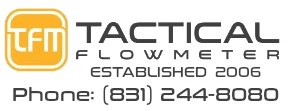How to verify and test a Coriolis Mass Flow Meter for proper operation:
- Make sure you have 24 VDC power and sufficient current ability to drive resonating circuit for the Coriolis Mass Flow Sensor. The Tactical Flow Meter Coriolis Mass flow meter consumes a max of 15 watts of power, or, at 24 VDC we need at least 620 mA of current per Coriolis Mass Flow Meter.
- Make sure your connection to your 4-20 or output frequency is according to the manual starting on page 6. Note that 4-20 mA circuits can not be wired in series or parallel with one another, as you most likely already know.
- Make sure your meter can properly OUTPUT the 4-20 or Frequency outputs by following the video at 4:56 in the video below. (You may ALSO launch the video DIRECTLY to the 4:45 time frame clicking this link, Note... it opens up a new YouTube page) Note this procedure drives the outputs of the meter for the purpose of ensuring connected devices, such as PLC's and the like properly extract the signal for processing. Connected devices will react as if the flow is actually present when using the commands shown above. The password is 020 to invoke the tests.
- If you are using ModBus you may wish to refer to the short intro video on the video below at the 6:45 time slot (You may ALSO launch the video DIRECTLY to the 4:45 time frame clicking this link, Note... it opens up a new YouTube page)
- MOST importantly, your meter must be ZEROED at the conditions you intend to use the meter. The procedure is below under the heading "Notes about ZERO Calibration on Coriolis meters."
Common issues users encounter:
- Not having enough current to drive the Coriolis Mass Flow meter, particularly when running more than one meter. Solution: Ensure the current capability of the power supply is n * (650 mA), where n is the number of Coriolis Mass Flow Meters on the power supply circuit.
- Not running the zero procedure after any new installation. Solution: Run the Zero procedure each time the meter is moved to another location or application.
- The accuracy does not seem right... Running two meters in series differs more than a single device uncertainty level... Let's say two devices that have an uncertainty of 1% of reading are run in series and we wish to determine if they are within spec. The proper method is to take the square root of the sum of the squares to determine the errors. For your 1% device the square root of 1^2 + 1^2 is the sqrt of 1 or 1.414, meaning the ERROR can be 1.414 and still be within the statistical mean of the accuracy spec. No wonder we did not like statistics. Note: Using two 0.5% devices we have 0.707% as the allowable total error.
How to help us help you:
- Send an email with a photo of the product label with a description of what you observe and what you EXPECT to observe.
- If you are using another device let us know the model number so we can research what you observe to allow us to swiftly assist.
Coriolis Mass Flow Meter User Interface Video
Coriolis User Interface and ModBus RTU

Notes about ZERO Calibration on Coriolis meters.
NOTE: It is critical to invoke the zero point calibration after installation.
Every Coriolis Meter must be zeroed in the final installation point with the fluid that will be measured.
Make sure the meter has warmed up for at least 15 minutes before invoking the zero function. Make sure the measuring tube is fully filled with liquid. Turn off the stop valves, make sure the liquid is in a stationary state, and enter password 20 to invoke calibrate the zero point. The zero function is in process when the display indicates "Adjust zero" for about 30 seconds and then reverts to the normal display mode, after you hit the bottom left Enter button to start the function. This function is CRITICAL to allow the meter to determine the resonant frequency of the measuring tube is to determine the density of the fluid within it. This step cannot be skipped. Once this step is complete you will want to confirm the measured density is accurate.
This is done in the main running screen by touching the up arrow (upper right hand corner) and confirm the indicated density agrees with the density of your fluid.
Coriolis mass flow meters directly measure the mass flow and the density of the fluid. The volume flow rate is calculated by mass flow divided by density. If the density measured at the zero point is not accurate, then the flow rates will be affected as well.
We show the process using the touch screen below

